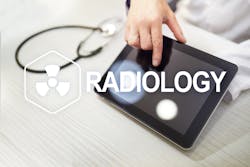How have radiology practices fared financially during the COVID-19 pandemic? Initially, very poorly, but many are now recovering, at least somewhat. That is the overall picture portrayed by the leaders of radiology practices and radiology divisions of integrated health systems, according to the speakers in a recent webinar on the subject.
“Pandemic Revenue Cycle Management: Perspectives and Practice,” was presented on August 17 by the editors of Diagnostic Imaging, and sponsored by Nashville-based Change Healthcare. The speakers were moderator Melody Mulaik, president of the Cedar Park, Tex.-based Revenue Cycle Coding Strategies; Christie James, senior manager for radiology revenue cycle optimization at Massachusetts General Hospital and immediate past president of the Fairfax, Va.-based Radiology Business Management Association (RBMA); and Greg Nicola, M.D., a practicing radiologist, executive leader at the Hackensack (New Jersey) Radiology Group, ad chair of the Commission on Economics at the Reston, Va.-based American College of Radiology (ACR).
Below are a few excerpts from their discussion.
Mulaik opened by saying, “Christie, talk about how COVID has impacted some of the payers?” “It has been a very challenging and unprecedented time for everyone at work, and for everyone in their families,” James replied. “As we work through this journey, everything’s new. And we have to be innovative, to react to changes on a dime. We’ll obviously make mistakes. But in my experience since March 11, the last time I stepped into my office in Boston—and our remote working has been extended until June 2021—they’ve given us the tools to do our job effectively. The payers are trying to learn as fast as we are; they’re trying to take their systems and navigate them to accept the various modifiers. The telehealth component went up to 75 percent, whereas our volume in radiology plummeted as much as 75 to 80 percent in some organizations. And the challenges of trying to maneuver your rev cycle around that are significant. The payers had a lot of difficulty applying the new modifiers required, the new documentation, the new regulations on the federal and state levels. And we’re having to build robust systems to make sure we capture every single charge possible and to make sure the claims process is as clean and efficient as possible. I have a lot of discussions with our IT teams constantly and with our payer relations folks. I think we’ve done a really good job, and the payers in New England have been very receptive, and I haven’t seen any unnecessary denials or delays in payment.”
“We haven’t seen any delay, but we’re mainly a diagnostic radiology practice,” Dr. Nicola noted. “For us, most of all, our revenue has just massively declined in this crisis. From the payer perspective, they’ve listened to what our needs are. Medicare and some of the commercial payers have done that. They’ve done a fairly good job of adapting things; they’ve had to be extremely nimble. This is extreme disruption. From a radiology perspective, our payments went massively down; however now, we’re seeing a rebound. Some our modalities, for example, screening mammography, haven’t yet come up. But because it’s been a fairly gradual upswing back to normal volumes, the precertification issue hasn’t been as much of a barrier as we had expected.”
What about staffing during the spring, when radiological procedure volume declined precipitously?
Mulaik asked her panelists, “Are there any challenges around achieving clean claims right now?” “We had to furlough or decrease our coding staff based on volume; and when that volume came roaring back from 50 percent capacity at baseline to 2 percent above capacity in our CT and MR areas, with ultrasounds and diagnostic mammograms, we focused on establishing robust coding programs, and making sure our diagnosis codes were absolutely correct, especially around COVID diagnoses, to make sure that those diagnoses were in the right places,” Mass General’s James responded. “We also have some very robust scrubbers in our area, to churn these claims against the payers’ rules. Our physicians are also finalizing their procedures very quickly. Our rejections, denials, write-offs, have not increased.”
How have elective procedures been impacted? “Well, the elective procedures were decimated at first,” Hackensack Radiology’s Nicola reported. “At our worst, we were down 85 percent in northern New Jersey, for about ten days, mainly because there weren’t elective procedures. Those slowly ramped back up over time, and we’re starting to see numbers comparable to prior to COVID.”
How did that impact your clinicians and staff? “We had to cut staff and furlough staff,” Nicola said. “We have about 20 partners out of about 45 radiologists, and the partners did not collect any salary for about two-and-a-half months, just to keep our business afloat. We wanted to keep our outpatient centers at a minimum level of throughput, and consolidated procedures in some of them. But the money from Medicare and the government through Payroll Protection and the Provider Relief Fund were just not enough to keep our business afloat, so we forewent partner salaries for two-and-a-half months.”
“Our senior leadership took a cut in pay,” James noted. “And we’re now rebranded as Mass General/Brigham rather than Partners; and all of our employees—are pensions are no longer funded for a year, and no merit increases or bonuses. But no one was laid off. And that’s because we were in an excellent position, from a cash position. We lost a lot of money, but we did get some money from the government, like everyone else, and we’ve been able to get back on our feet, because our volume came back so quickly, and our pensions will be re-funded by the end of the year.”
Telehealth’s impact
“There are some things that we’ve learned from COVID,” Mulaik said. “One has been around telehealth. How has telehealth impacted your situation?” “We’ve done some telehealth with the interventional radiology department; but the diagnostic radiologists aren’t doing telehealth,” Nicola reported. “And even little things can disrupt practice. We always have to be experimenting with new ways to bring folks together and make patients happy. Had we experimented with telehealth earlier, we might have come to it earlier. Now, this is anecdotal, but we’ve seen more imaging coming out of telehealth visits. There are guess as to why that is; perhaps it’s because the patient hasn’t seen their doctor in a while. But we worry that it might make more doctors uneasy about diagnosing. Right now, there are too many variables involved. We need to let the politicians and everyone else, but we’ve seen anecdotally before COVID that it could lead to more downstream imaging.”
“In the interventional radiology space,” Mass General’s James said, “we’re looking at building a more robust telehealth program, to allow our patients to access care more quickly. We’re seeing that the time period between a biopsy ad the patient seeing a specialist, has shortened. So the time from consult to procedure has shortened. And we probably would still be where we were before COVID, with telehealth. And as a consumer, I like telehealth. They’re predicting a 40-percent lowered detection rate of cancer detection because of people not seeking care over the last four months. So I don’t know exactly how that will impact imaging.”
“If things had continued as they were before COVID, Medicare likely wouldn’t have supported the telehealth as it did,” Mulaik noted. “But what longer-term innovations might come about as a result?”
“It is unfortunate that patient-centric care needs disruption in order to thrive. And we now have virtual waiting rooms. Why would anyone want to sit in a waiting room? Now, we have virtual waiting rooms. And patients like it because they’re safer nw. And so we’ve created the concept of no more waiting. You pre-register, you’ve moved to preparedness for your visit. And we still have a little bit of imaging capability eat imaging centers. And our CT volume has never reached 100 percent of capacity. And moving to electronic has allowed a lot of our people to become more efficient.”
“From a billing office perspective ,we’ve been able to simplify our processes a great deal, and we’ve been able to improve our communications considerably, because we’re virtual,” James added. “So it’s like having someone sitting right next to you. For example, I could look at all my dashboards and share them with staff. So our operations are actually more efficient now.”


